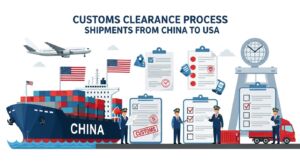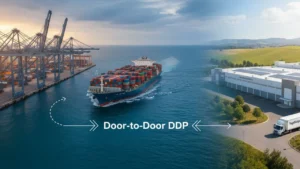Welcome to our comprehensive guide on air freight terms! If you’re new to the world of logistics and shipping, understanding the various terminologies involved in air freight can be overwhelming. Fortunately, this guide is here to help you navigate through the jargon and make sense of it all. In this article, we’ll provide a detailed overview of the most commonly used air freight terms, explain their meanings and offer practical examples to illustrate their usage. Whether you’re a business owner or a logistics professional, this guide is an essential tool for anyone involved in air freight transportation. So, let’s get started!
Air Waybill (AWB)
A bill of lading that covers both domestic and international flights transporting goods to a specified destination.
An air waybill is a document that accompanies goods shipped by air. It serves as a contract between the shipper and the carrier and contains information about the shipment such as the shipper’s name and address, the consignee’s name and address, the flight details, and a description of the goods being shipped. The air waybill is not a negotiable document and is non-transferable. It is used to track the shipment and to provide proof of delivery.
Aircraft Container
A unit load device (ULD) which links directly with the airplane cargo handling and restraint system.
An aircraft container is a unit load device (ULD) that is used to transport cargo on an airplane. It is designed to fit directly into the airplane’s cargo handling and restraint system and can be loaded and unloaded quickly and efficiently. Aircraft containers come in a variety of sizes and shapes to accommodate different types of cargo.
Allotment
A term used to describe blocked space by airlines on behalf of forwarders/shippers.
An allotment is a term used to describe blocked space by airlines on behalf of forwarders/shippers. It is a pre-arranged agreement between the airline and the forwarder/shipper to reserve a certain amount of space on a flight for cargo. The allotment can be for a specific period of time or for a specific number of flights.
Allotments are used by forwarders and shippers to ensure that they have space available on a flight for their cargo. They are also used by airlines to guarantee that they will have a certain amount of cargo on their flights.
Break Bulk
The separation of a consolidated shipment into individual shipments.
Break bulk is the separation of a consolidated shipment into individual shipments. It is the process of breaking down a shipment that has been consolidated into smaller shipments for delivery to different destinations. This process is often used when the original shipment is too large to be delivered to a single destination.
Break bulk can be done manually or with the use of machinery. The process involves separating the original shipment into smaller shipments and then re-packaging them for delivery to their respective destinations.
Cargo Manifest
A document that lists the cargo carried on a ship or airplane.
A cargo manifest is a document that lists the cargo carried on a ship or airplane. It is used to provide information about the cargo being transported and to ensure that it is loaded and unloaded correctly. The cargo manifest contains information about the shipper, the consignee, the type of cargo being transported, and the quantity of each item.
The cargo manifest is an important document for customs officials and other regulatory agencies. It is used to verify that the cargo being transported complies with all applicable regulations and to ensure that it is properly declared for customs purposes.
Carrier
A company that transports goods or people.
A carrier is a company that transports goods or people. It can be an airline, a shipping company, a trucking company, or any other type of transportation company. Carriers are responsible for the safe and timely transport of goods or people from one location to another.
Carriers are regulated by various government agencies to ensure that they comply with safety regulations and other requirements. They are also required to carry insurance to protect against loss or damage to the goods being transported.
Cartage
The movement of goods by truck from one location to another.
Cartage is the movement of goods by truck from one location to another. It is the process of transporting goods over short distances, such as from a warehouse to a distribution center or from a port to a nearby storage facility.
Cartage is often used in conjunction with other modes of transportation, such as air or sea transport. It is an important part of the logistics chain and is used to ensure that goods are transported quickly and efficiently.
Certificate of Origin
A document that certifies the country of origin of goods being shipped.
A certificate of origin is a document that certifies the country of origin of goods being shipped. It is used to provide information about the origin of the goods and to ensure that they comply with all applicable regulations.
The certificate of origin is an important document for customs officials and other regulatory agencies. It is used to verify that the goods being transported comply with all applicable regulations and to ensure that they are properly declared for customs purposes.
Chargeable Weight
The weight used to calculate the cost of air freight.
Chargeable weight is the weight used to calculate the cost of air freight. It is the greater of the actual weight of the shipment or the dimensional weight. The dimensional weight is calculated by multiplying the length, width, and height of the shipment and dividing by a factor that varies depending on the airline.
Chargeable weight is an important factor in determining the cost of air freight. It is used to ensure that shippers are charged appropriately for the space that their cargo occupies on an airplane.
Charter
The rental of an entire aircraft or ship for a specific purpose.
A charter is the rental of an entire aircraft or ship for a specific purpose. It is often used by companies, governments, or individuals who need to transport a large number of people or a large amount of cargo to a specific location.
Charters can be arranged for one-time events or for ongoing transportation needs. They are often used for business travel, sports teams, and other large groups.
Here is a link to the air charters if you would like more information.
Consignee
The person or company to whom goods are shipped.
A consignee is the person or company to whom goods are shipped. It is the recipient of the shipment and is responsible for receiving and inspecting the goods upon delivery.
The consignee is often different from the shipper, who is the person or company that sends the goods. The consignee is typically identified on the bill of lading or other shipping documents.
Customs Broker
A person or company that helps importers and exporters comply with customs regulations.
A customs broker is a person or company that helps importers and exporters comply with customs regulations. They are responsible for ensuring that all necessary documentation is completed accurately and on time, and that all applicable duties and taxes are paid.
Customs brokers are licensed by the government and are required to pass an exam to demonstrate their knowledge of customs regulations. They work closely with importers and exporters to ensure that their shipments are processed quickly and efficiently.
Demurrage
A fee charged for the detention of a shipment beyond the time allowed for loading or unloading.
Demurrage is a fee charged for the detention of a shipment beyond the time allowed for loading or unloading. It is intended to compensate carriers for the additional costs they incur when shipments are delayed.
Demurrage fees can be significant and can add up quickly if a shipment is delayed for an extended period of time. They are typically charged on a per-day basis and can vary depending on the type of shipment and the carrier.














